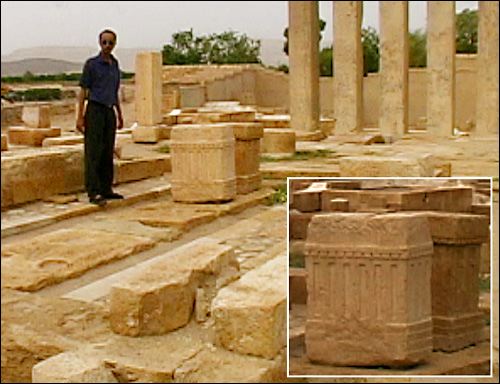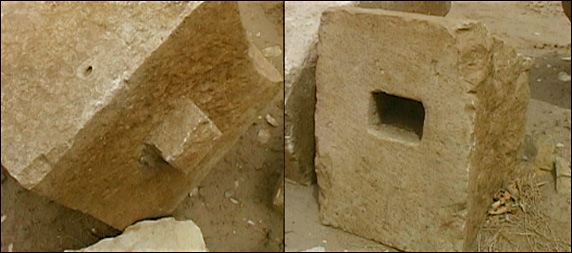
|
Nassir points to the sacrificial altar at Marib's Temple of the Sun, or Bara'An where large bulls were slaughtered almost 3000 years ago. Stone conduits received the fresh blood and carried it away as an offering. In the back are five of the tall, rectangular monoliths that are characteristic of Sabaean temple architecture. Although they constructed almost everything in stone, Sabaean building techniques and their devotion to detail were quite sophisticated for their historical era. The large columns were pieced together with an ingenious peg and hole construction (see below). Not only were stones fitted without the need for mortar, the face of the stones was often highly polished and covered with artistic details. The fact that many of the ancient temples -- some over 3500 years old -- remained intact when excavated is a testament to the engineering and skill of Sabaean masons. Excavations revealed that there were multiple foundations on this same site dating back to several thousands of years ago. The recent temple was devoted to the Sun and was aligned to measure the position of celestial bodies. There was a large well that was located in the central temple area and it appears that this was used for oblation or ritualistic washing prior to making the animal sacrifice. We know little of this ancient ritual and excavations have only penetrated about 10 meters to date.

We filmed the entire temple but were asked to refrain from photographing the inscription on the four corners of the main altar stone. The curator of the site explained that the site had just recently been excavated by a team from Germany. The German team's attempts at a translation were not ready to be made public. We were not prohibited from sketching the text. Later, in the comfort of the air conditioned Bilquis Hotel, we translated the sketch using the Negev algorithm. The results, were in keeping with the other Sabaean writing contemporary to Bilquis (the Queen Mother) and her only son, Menelek (the Son). This ancient script uses proto-Semitic dialects and a proto-Canaanite alphabet that later developed into the Ethiopian Hymaritic language. The script and translation make reference to Saba's son, Menelek, who was buried in an underground chamber with the Ark of the Covenant following its move from Jerusalem [See First Tongue article in ViewZone]. The Son's burial frustrated the Queen and her people. There were fears that invading nations would destroy the chamber if news of the Ark's location was widely known. The Queen eventually moved her kingdom from Marib, across the Red Sea to Ethiopia, and left her son's buried chamber to be forgotten by time and sand. Other pieces of this earlier script refer to a prophesy that someday, when the Sabaean kingdom was no more, the chamber would be discovered and the Ark re-activated. The location of this chamber is believed to be in the Bilquis Temple of Marib, currently under the control of the University of Calgary's archaeological team.
|
Previous Page || ViewZone || --next-->